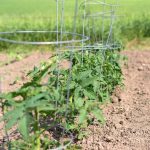To get more tomatoes from each plant, follow these 5 secrets: provide ample sunlight, water consistently, trim off suckers, fertilize regularly, and support the plants with stakes or cages. Growing robust tomato plants with high yields requires implementing these key strategies.
To ensure healthy growth, sunlight is crucial, so find a sunny spot in your garden for your tomato plants. Additionally, watering consistently and evenly throughout the season will prevent issues like blossom end rot. Moreover, pruning off the suckers, or new growth, will allow the plant to put more energy into fruit production.
Regular fertilization with a balanced fertilizer will provide essential nutrients for optimum growth and fruit development. Lastly, supporting the plants with stakes or cages will prevent them from drooping or breaking under the weight of the tomatoes. By following these secrets, you can enjoy a bountiful harvest of homegrown tomatoes.
Understanding Tomato Plants
Tomatoes are not only a staple in our gardens, but also in our diets. These juicy red fruits are not only delicious, but also highly nutritious. If you’re an avid home gardener, you probably know that tomatoes can be a bit finicky to grow. However, by understanding the nature of tomato plants and their growth, you can ensure a bountiful harvest every single time.
Brief Overview Of Tomato Plants
Before we dive into the secrets of maximizing tomato plant yield, let’s take a brief overview of these green wonders. Tomato plants, scientifically known as Solanum lycopersicum, belong to the nightshade family of plants. They are warm-season perennials, typically grown as annuals, and are native to western South America. These plants can reach a height of six to ten feet and have a sprawling habit. Tomatoes come in different varieties, including determinate and indeterminate types, each with its own growth characteristics.
The Importance Of Understanding Tomato Plant Growth
Understanding how tomato plants grow is essential if you want to maximize your harvest. It helps you identify potential problems, implement necessary care, and make informed decisions throughout the growing season. By being aware of the stages of a tomato plant’s growth, you can provide the optimal conditions that promote vigorous growth, enhance fruit production, and mitigate common issues.
Let’s explore the key stages in the growth of a tomato plant:
- Germination: This is the stage when a tomato seed sprouts and transforms into a seedling.
- Seedling: During this stage, the seedling develops its first true leaves and continues to grow in size.
- Vegetative Growth: In this stage, the plant focuses on developing a strong root system and lush foliage. It prepares itself for the flowering and fruiting stage.
- Flowering: At this stage, the tomato plant forms beautiful clusters of yellow blossoms, which eventually turn into fruit.
- Fruit Development: After successful pollination, the plant directs its energy towards fruit development. Green tomatoes start to form and slowly mature into luscious red (or other colors depending on the variety) fruits.
- Ripening: The final stage is when the tomato fruit gradually ripens, indicating it is ready to be harvested and enjoyed.
By understanding these stages, you can time your planting and care routines accordingly, ensuring each step of the growth process receives the attention it needs to flourish. Each stage presents unique challenges and opportunities that, when managed well, can significantly improve your tomato yield.
Now that we have a firm grasp on the basics of tomato plant growth, it’s time to dive into the secrets that will help you get more tomatoes from every single plant. In the following sections, we’ll explore the crucial factors that contribute to optimal tomato plant care, ultimately leading to a more productive and rewarding harvest.
:strip_icc()/101976630-93b40a9ca69542b3bde9b59917627d68.jpg)
Credit: www.bhg.com
Secret 1: Choosing The Right Tomato Varieties
Choosing the right tomato varieties is the first secret to getting more tomatoes from every single plant in your garden. It is important to select varieties that are well-suited to your climate and growing conditions to ensure a successful harvest.
Choosing the right tomato varieties is the first secret to getting more tomatoes from every single plant. With countless options available, selecting the right varieties can seem overwhelming. However, by considering a few key factors, you can choose tomato varieties that are most likely to give you a high yield. Let’s explore the best tomato varieties for high yield and the factors to consider when selecting them.
Best Tomato Varieties For High Yield
Not all tomato varieties are created equal when it comes to producing a bountiful harvest. To maximize your tomato yield, consider these top-performing varieties:
| Variety | Characteristics |
|---|---|
| 1. Celebrity | Highly productive and disease-resistant, producing medium-sized, flavorful tomatoes. |
| 2. San Marzano | A classic paste tomato variety known for its rich flavor and high yield. |
| 3. Cherokee Purple | Heirloom variety with large, sweet tomatoes known for their exceptional taste. |
| 4. Early Girl | A popular early-season tomato variety that produces well in various climates. |
| 5. Better Boy | A reliable hybrid variety that consistently produces large, juicy tomatoes. |
Factors To Consider When Selecting Tomato Varieties
When selecting tomato varieties, keep these factors in mind to ensure optimal yield:
- Climate suitability: Choose varieties that are well-suited to your local climate. Some varieties are better adapted to hot and humid areas, while others thrive in cooler regions.
- Growth habit: Consider the growth habit of the tomato variety. Determinate varieties are more compact and suitable for container gardening, while indeterminate varieties are vine-like and often require staking or trellising.
- Disease resistance: Look for tomato varieties that have disease resistance. This can help reduce the risk of common tomato diseases, such as blight or wilt, which can significantly impact yield.
- Maturation time: Consider the maturation time of the tomato varieties. If you have a shorter growing season, choose early maturing varieties to ensure a timely harvest.
- Taste preference: Don’t forget to factor in personal taste preferences. Some varieties may excel in taste, while others are better suited for canning or sauces.
By taking these factors into account, you can choose tomato varieties that are well-suited to your specific growing conditions and preferences, increasing the likelihood of a successful and abundant tomato harvest.
Secret 2: Optimal Tomato Planting Techniques
When it comes to growing tomatoes, the success of your harvest largely depends on the planting techniques you employ. Understanding the best timing and spacing for planting tomatoes, as well as preparing the soil properly, are crucial in maximizing the yield of each tomato plant. In this article, we will delve into the secrets of optimal tomato planting techniques, providing you with all the information you need to get more tomatoes from every single plant.
Timing And Spacing For Planting Tomatoes
Timing and spacing are key factors that can significantly affect the growth and productivity of your tomato plants. By understanding the appropriate time to plant and the optimal distance between plants, you can create an ideal environment for your tomatoes to thrive.
Know the right time to plant
Tomatoes are warm-season crops that require ample sunlight and warmth to grow. Before planting, it’s crucial to wait until the risk of frost has passed and the soil has warmed up. Typically, this is around two weeks after the last expected frost date in your region. By waiting for the right time, you can protect your plants from potential damage and ensure a healthier start for them.
Provide adequate spacing
Proper spacing is essential for the optimal growth of your tomato plants. When plants are too close together, they compete for sunlight, water, and nutrients, leading to a weaker harvest. On the other hand, spacing them too far apart can waste valuable gardening space. To strike the right balance, it is recommended to space tomato plants approximately 18 to 36 inches (45 to 90 cm) apart, depending on the specific tomato variety. This provides enough room for each plant to receive sufficient sunlight and air circulation, promoting better overall plant health.
Tips For Preparing The Soil For Tomato Planting
Preparing the soil properly is critical for creating the optimal conditions for your tomato plants to grow and produce an abundance of juicy tomatoes. By following these tips, you can ensure that your plants have the best possible start:
- Choose a sunny location: Tomatoes thrive in full sunlight. Select a spot in your garden that receives at least six to eight hours of direct sunlight each day.
- Loosen the soil: Before planting, loosen the soil in the designated area using a garden fork or tiller. This helps to improve drainage, allowing the roots to penetrate the soil more easily.
- Amend the soil: Add organic matter such as compost or well-rotted manure to enrich the soil. This provides essential nutrients and improves the soil structure, promoting healthy root development and increased tomato yield.
- Weed thoroughly: Remove any existing weeds from the planting area. Weeds compete with your tomato plants for vital resources, so keeping the area clear helps to reduce their impact on your crop.
- Check the pH level: Tomatoes prefer slightly acidic soil with a pH range of 6.0 to 6.8. Test the soil using a pH testing kit, and if necessary, adjust it by adding lime to raise pH or sulfur to lower pH.
By following these tips and preparing the soil properly, you can lay a solid foundation for your tomato plants, setting them up for optimal growth and a bountiful harvest.
Secret 3: Proper Tomato Plant Care
Proper care is crucial for ensuring a bountiful tomato harvest. By providing your tomato plants with the right amount of water, nutrients, and support, you can maximize the yield from each plant. In this section, we’ll explore two key aspects of tomato plant care: watering and fertilizing the plants, and methods to support their growth.
Watering And Fertilizing Tomato Plants
When it comes to watering tomato plants, finding the right balance is essential. Overwatering can lead to root rot and other diseases, while underwatering can result in stunted growth and reduced fruit production. To keep your tomato plants healthy and productive, follow these guidelines:
- Consistent Moisture: Tomatoes need consistent moisture in the soil, but they don’t like to sit in waterlogged soil. Water deeply once or twice a week, keeping the soil evenly moist without causing it to become waterlogged.
- Mulching: Applying a layer of organic mulch around the base of the plants can help retain moisture in the soil, prevent weeds, and regulate soil temperature.
- Fertilization: Tomatoes are heavy feeders and require regular fertilization to thrive. Use a balanced, slow-release fertilizer or organic compost when planting, then supplement with liquid fertilizer every two to three weeks during the growing season.
Methods To Support Tomato Plant Growth
To support the vigorous growth of tomato plants and prevent breakage under the weight of the fruits, consider employing these techniques:
- Staking: Staking is a common method that involves tying the main stem of the tomato plant to a sturdy stake. This helps maintain an upright position and prevents the plant from sprawling on the ground.
- Caging: Tomato cages are another popular option, especially for determinate varieties. Cages provide support to the entire plant and allow it to grow vertically, saving space in your garden.
- Trellising: Trellising involves training the tomato plants to grow on a trellis or a fence. This method encourages vertical growth and provides ample air circulation, reducing the risk of diseases.
By giving your tomato plants proper care, you can optimize their growth and productivity. Remember to keep the soil consistently moist, provide regular fertilization, and support the plants with staking, caging, or trellising techniques. Following these practices will help you get more tomatoes from every single plant.
Secret 4: Effective Pest And Disease Management
Learn the secrets to effectively managing pests and diseases for optimal tomato plant growth. Maximize your tomato yield with these valuable tips.
Common Tomato Plant Pests And Diseases
Tomatoes are undeniably one of the most popular plants to grow in home gardens. However, as with any plant, tomato plants are also susceptible to various pests and diseases that can hinder their growth and reduce fruit production. Being aware of the common tomato plant pests and diseases is the first step in effectively managing them. Some of the most frequent culprits include:Natural And Organic Methods To Prevent And Treat Issues
When it comes to pest and disease management in your tomato plants, resorting to natural and organic methods is not only safe for the environment but also better for your health. Below, we have compiled a list of proven techniques to prevent and treat common tomato plant issues:1. Companion Planting: Intercropping your tomato plants with pest-repellent herbs such as basil, marigold, or mint can help deter various insects that tend to attack tomatoes.2. Neem Oil Spray: Neem oil, derived from the neem tree, is an effective natural insecticide and fungicide. Dilute neem oil in water according to the instructions, and spray it on your tomato plants to combat a wide range of pests and diseases.3. Good Sanitation Practices: Proper sanitation is crucial for preventing the spread of diseases in your tomato plants. Regularly remove any fallen leaves, dead plant material, or weeds around your tomato plants to reduce the risk of infection.4. Mulching: Applying a layer of organic mulch around your tomato plants not only helps conserve soil moisture but also acts as a physical barrier against soil-borne diseases.5. Proper Watering Techniques: Consistent watering is essential for healthy tomato plants, but overwatering or watering from above can lead to foliar diseases. Water at the base of the plants using drip irrigation or a soaker hose to keep the foliage dry.Effective Pest And Disease Management For Healthy Tomatoes
Investing time and effort in effectively managing pests and diseases in your tomato plants will ensure a bountiful harvest. By incorporating natural and organic methods into your gardening routine, you can protect your plants without resorting to harmful chemicals. Whether you choose companion planting, neem oil spray, sanitation practices, mulching, or proper watering techniques, each step plays a vital role in maintaining the health and productivity of your tomato plants. So, give these methods a try and enjoy an abundance of delicious tomatoes from every single plant in your garden!Secret 5: Maximizing Tomato Plant Productivity
Discover the secret to maximizing tomato plant productivity with these 5 proven techniques. Learn how to get more tomatoes from every single plant and enjoy a bountiful harvest.
Once you’ve nourished your tomato plants with the right soil, water, and sunshine, it’s time to focus on secret 5 to ensure maximum productivity. By employing effective pruning and trimming techniques, as well as mastering the art of harvesting and storing tomatoes, you can increase your yield and enjoy an abundance of fresh, flavorful tomatoes throughout the season.
Pruning And Trimming Techniques To Increase Yield
Pruning and trimming are essential practices to promote healthy growth and increase tomato plant productivity. By selectively removing certain parts of the plant, you can redirect energy toward fruit production and ensure proper airflow and sunlight penetration. Here are some effective techniques:
- Remove Suckers: Start by identifying the suckers, which are small shoots that emerge between the main stem and branches. These suckers divert energy from fruit production, so it’s crucial to remove them. Use clean, sharp pruning shears to carefully pinch or cut the suckers when they are still young.
- Limit the Number of Stems: While tomato plants can develop multiple stems, limiting them to one or two main stems encourages stronger growth and higher yield. Choose the strongest stem(s) to keep and remove any additional ones.
- Remove Indeterminate Branches: Indeterminate tomatoes continue growing indefinitely, often resulting in excessive foliage that blocks sunlight from reaching the lower branches. Regularly trim away the lower branches, allowing for better airflow and sunlight distribution throughout the plant.
Harvesting And Storing Tomatoes For Prolonged Freshness
Harvesting your tomatoes at the right time and storing them properly can significantly impact their taste and longevity. By following these best practices, you can enjoy fresh tomatoes for weeks:
- Pick at the Peak of Ripeness: Tomatoes taste best when fully ripe. Look for firm, evenly colored fruits with a slight give when gently squeezed. Avoid waiting until they are overly soft or mushy.
- Twist and Snap: To harvest your tomatoes without damaging the plant, gently twist the fruit until it detaches from the stem. If it doesn’t come off easily, use your pruning shears to cut the stem about half an inch above the fruit.
- Proper Storage Conditions: After harvesting, place your tomatoes in a single layer in a cool, well-ventilated area away from direct sunlight. Keep them stem-side up to prevent moisture loss. Avoid storing them in the refrigerator, as it can negatively affect their flavor and texture.
- Consider Ripening Techniques: If you have unripe tomatoes at the end of the season, you can encourage ripening by placing the fruits in a brown paper bag with a ripe banana or apple. These fruits release ethylene gas, which speeds up the ripening process.
By mastering these pruning and trimming techniques and adopting proper harvesting and storing practices, you’ll optimize your tomato plant’s productivity and enjoy a bountiful harvest of juicy, mouthwatering tomatoes. The effort you put into caring for your plants will undoubtedly be rewarded with an abundance of homegrown goodness.
Frequently Asked Questions On 5 Secrets To Get More Tomatoes From Every Single Plant
How Can I Get More Tomatoes From My Plants?
To get more tomatoes from your plants, make sure they receive plenty of sunlight, water them regularly, provide support for their vines, and remove any suckers. Additionally, using organic fertilizers and pruning the plants can also promote more tomato production.
When Is The Best Time To Harvest Tomatoes?
The best time to harvest tomatoes is when they are fully ripe and have reached their full color. Gently squeeze the tomatoes, and if they feel slightly soft, it’s time to harvest. Harvesting in the morning or evening when temperatures are cooler can also help maintain their flavor and quality.
How Often Should I Water Tomato Plants?
Tomato plants require regular watering to thrive. Typically, it’s best to water them deeply once or twice a week, depending on the weather conditions. Ensure that the soil is consistently moist but not waterlogged. Watering in the morning allows the leaves to dry off during the day and reduces the risk of disease.
Conclusion
By following these five secrets, you can maximize your tomato yield and enjoy a bountiful harvest. From choosing the right variety and providing suitable growing conditions to implementing proper pruning and disease prevention techniques, you have the power to enhance the productivity of each tomato plant.
Remember to consistently monitor and care for your plants, and the rewards will be deliciously satisfying. Get ready to savor the taste of success with your garden-fresh tomatoes! So, start implementing these secrets today and witness the difference they make in your tomato crop.

I am a graduate of Bangladesh Agricultural University, where I delved into various agricultural disciplines, equipping me with a profound understanding of agriculture. Beyond academics, I have hands-on experience in gardening and crop cultivation. My passion is to embrace sustainable farming and horticulture. With a BSc in Agriculture, I am dedicated to promoting environmentally conscious and efficient agrarian practices.
Bachelor of Science (BSc) in Agriculture (Hons.)
Master of Science. (Sustainable Agriculture & Food Security ) (MS)
Bangladesh Agricultural University




